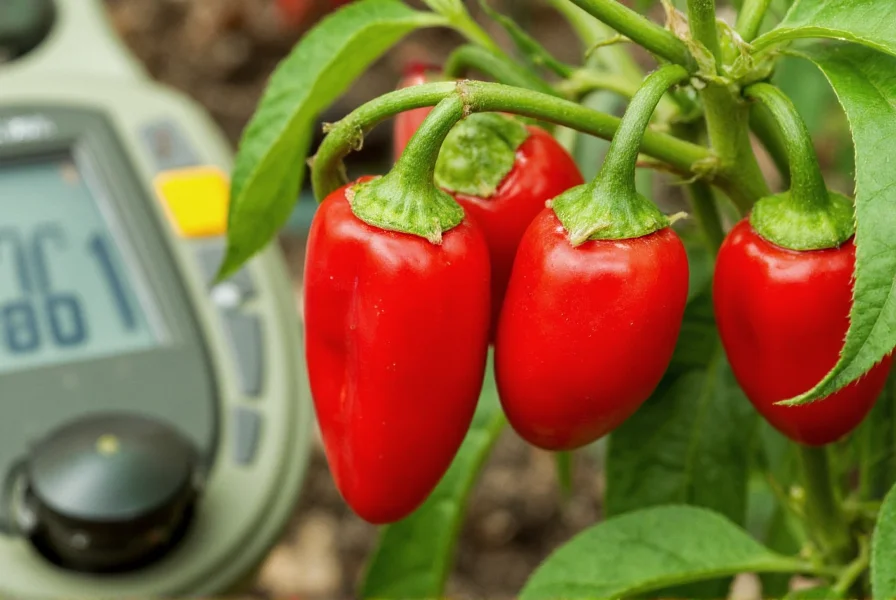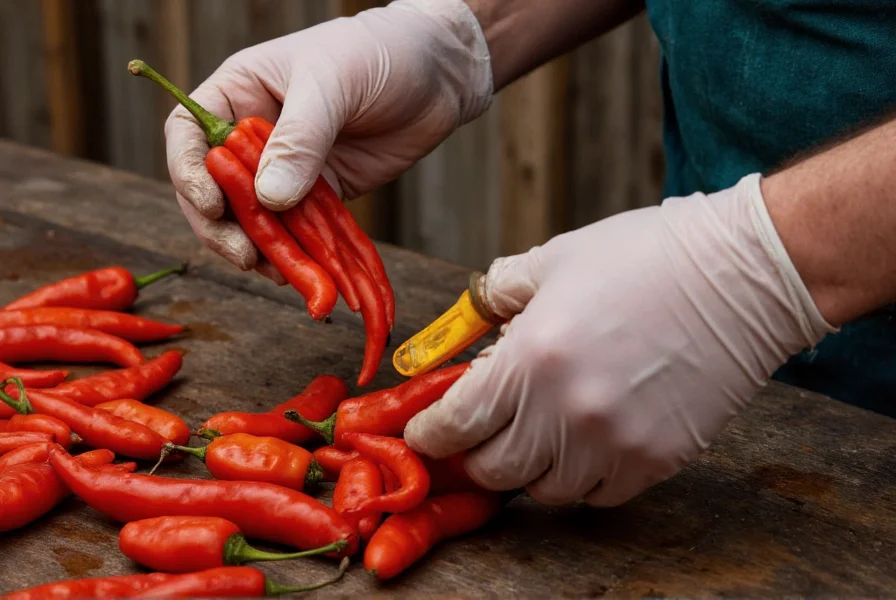The Scoville scale, developed by pharmacist Wilbur Scoville in 1912, measures the pungency or 'heat' of chili peppers and other spicy foods. Understanding how hot is a ghost pepper in Scoville units requires context about where it stands compared to more familiar peppers.
Ghost Pepper Heat Level Explained
When evaluating how hot is a ghost pepper compared to jalapeño, the difference is staggering. A typical jalapeño measures 2,500-8,000 SHU, making the ghost pepper approximately 100-400 times hotter. This extreme heat comes from capsaicinoids, particularly capsaicin and dihydrocapsaicin, which trigger pain receptors in the mouth and throat.
| Pepper Variety | Scoville Heat Units (SHU) | Heat Comparison |
|---|---|---|
| Bell Pepper | 0 SHU | Mild |
| Jalapeño | 2,500-8,000 SHU | 1x (baseline) |
| Habanero | 100,000-350,000 SHU | 12-40x hotter than jalapeño |
| Ghost Pepper (Bhut Jolokia) | 855,000-1,041,427 SHU | 100-400x hotter than jalapeño |
| Carolina Reaper | 1,400,000-2,200,000 SHU | 175-880x hotter than jalapeño |
Origin and Recognition of the Ghost Pepper
Native to Northeast India, the ghost pepper (Bhut Jolokia, meaning 'ghost chile' in Assamese) gained international recognition when it was verified by Guinness World Records in 2007 as the world's hottest chili pepper—a title it held until 2011. The name 'ghost' refers to how the heat seems to sneak up on you, almost like a ghost.
Researchers at New Mexico State University's Chile Pepper Institute conducted the official testing that confirmed the ghost pepper's heat level. Their measurements found consistent results in the 855,000-1,041,427 SHU range, with an average around 1 million SHU.

Physical Effects of Consuming Ghost Peppers
Understanding what happens when you eat a ghost pepper is crucial for anyone considering trying one. The intense heat triggers immediate physiological responses:
- Immediate burning sensation that starts in the mouth and can spread throughout the body
- Profuse sweating and increased heart rate as the body tries to cool down
- Tears and nasal discharge as the body attempts to flush out the capsaicin
- Endorphin release that can create a temporary 'high' feeling
- Temporary numbness in the mouth after the initial burning subsides
The duration of ghost pepper burn typically lasts 20-45 minutes for the intense phase, though residual effects can linger for several hours. The question of how long does ghost pepper burn last depends on individual tolerance, the amount consumed, and what you eat to counteract the heat.
Safety Considerations with Super-Hot Peppers
While ghost peppers aren't dangerous for most healthy adults in moderate quantities, certain precautions are essential:
Never handle ghost peppers without gloves, as capsaicin can transfer to sensitive areas like eyes. The question of is ghost pepper dangerous to eat has a nuanced answer—while not toxic, consuming large quantities can cause severe stomach pain, vomiting, and in rare cases, temporary breathing difficulties.
Individuals with gastrointestinal conditions like ulcers, IBS, or GERD should avoid ghost peppers entirely. Children and pets should never consume super-hot peppers. If you experience severe reactions after eating ghost pepper, seek medical attention.

Culinary Uses of Ghost Peppers
Despite their intense heat, ghost peppers have legitimate culinary applications when used properly. Chefs who understand what does ghost pepper taste like beyond just the heat describe complex flavor notes:
- Fruity undertones with subtle smokiness
- Sweetness that emerges after the initial heat subsides
- Earthy, floral notes characteristic of Northeast Indian chilies
In traditional Northeast Indian cuisine, ghost peppers are used sparingly in chutneys, pickles, and meat dishes. Modern applications include hot sauces, specialty salsas, and even ghost pepper-infused chocolates for adventurous palates. The key is using minimal amounts—often just a few seeds or a small slice of pepper—to add heat without overwhelming other flavors.
Ghost Pepper vs. Other Super-Hot Peppers
While ghost peppers were once the undisputed champions of heat, newer varieties have surpassed them. Understanding ghost pepper vs Carolina reaper heat reveals significant differences:
- Ghost Pepper: 855,000-1,041,427 SHU, fruity flavor profile, Indian origin
- Carolina Reaper: 1.4-2.2 million SHU, slightly sweeter with hints of cinnamon, American hybrid
- Trinidad Moruga Scorpion: 1.2-2 million SHU, intense upfront heat with citrus notes
- Dorset Naga: 876,000-939,000 SHU, similar heat to ghost pepper but with different flavor profile
For home gardeners wondering can you grow ghost peppers at home, the answer is yes—but with caution. They require warm temperatures, well-draining soil, and careful handling. Many gardeners report success growing ghost peppers in containers to control their spread.
Frequently Asked Questions
How many times hotter is a ghost pepper than a jalapeño?
A ghost pepper is approximately 100-400 times hotter than a jalapeño. While jalapeños measure 2,500-8,000 Scoville Heat Units (SHU), ghost peppers range from 855,000 to 1,041,427 SHU. This dramatic difference means even a small amount of ghost pepper can overwhelm dishes that would normally use several jalapeños.
What's the best way to neutralize ghost pepper burn?
Milk, yogurt, or other dairy products containing casein are most effective for neutralizing ghost pepper burn, as casein binds to capsaicin and helps wash it away. Avoid water, which spreads the oil. Sugar, honey, or starchy foods like bread can also help absorb capsaicin. For skin exposure, rubbing alcohol or oil (which dissolves capsaicin) followed by soap and water works better than plain water.
Can eating ghost peppers cause permanent damage?
No, eating ghost peppers does not cause permanent damage to healthy individuals when consumed in reasonable quantities. The intense burning sensation is temporary, though extremely spicy peppers can cause temporary gastrointestinal distress. People with pre-existing conditions like ulcers or inflammatory bowel disease should avoid super-hot peppers. The body's reaction to capsaicin is a temporary neurological response, not actual tissue damage.
Why do ghost peppers feel hotter over time?
Ghost peppers create a delayed heat effect because capsaicin first stimulates then desensitizes pain receptors. Initially, you might experience moderate heat, but as more capsaicin molecules bind to receptors throughout your mouth and throat, the sensation intensifies. This 'creeping heat' characteristic is why they're called 'ghost' peppers—the heat seems to sneak up on you unexpectedly after initial consumption.
How should I handle ghost peppers safely?
Always wear nitrile or latex gloves when handling ghost peppers, and avoid touching your face. Work in a well-ventilated area as capsaicin vapors can irritate eyes and lungs. Use separate cutting boards and utensils that won't be used for other foods. After handling, wash all surfaces with soapy water and dispose of gloves properly. Never cut ghost peppers near children or pets, and store them securely away from regular cooking areas.











 浙公网安备
33010002000092号
浙公网安备
33010002000092号 浙B2-20120091-4
浙B2-20120091-4